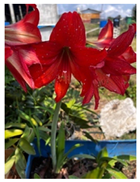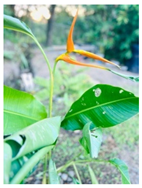Abstract
The aim of this research was to evaluate the efficiency of horizontal subsurface flow-constructed wetlands (HSSFWs) planted with Hippeastrum striatum and Heliconia lastisphata for the treatment of contaminated river waters by wastewater from the dairy industry (WDI) and domestic wastewater in tropical climates over a study period of 136 days. Cell with a real volume of 780,000 mL and a flow rate of 1.805 mL s−1. The hydraulic retention time was determined to be 5 days. 12 individuals of Hippeastrum striatum were planted at a distance of 20 cm from each other in one cell, while in another cell, 12 individuals of Heliconia spp. were planted. An adaptation period was determined for both species. Subsequently, the experiment was started, and the elimination percentages obtained were as follows: COD: 67.94 ± 1.39%, 63.17 ± 2.63%; TSS: 56.49 ± 5.73%, 48.78 ± 5.87%; N-NH4: 51.06 ± 2.16%, 50.80 ± 1.91%; TN: 44.36 ± 5.73%, 30.59 ± 5.87%; TP: 47.00 ± 5.32%, 35.57 ± 4.06%; DO: 50.23 ± 1.61%, 47.74 ± 1.34%; and pH: 6.81 ± 0.07, 6.52 ± 0.1, for Heliconia lastisphata and Hippeastrum striatum, respectively. These results demonstrate that both macrophyte species can be used for the treatment of wastewater from the dairy industry using HSSFWs; cheese factories could be involved in the development of constructed wetland systems to reduce the environmental impact of the industry.
1. Introduction
The increase in demand for milk and dairy products, such as different types of cheese and other by-products, has opened up important avenues for growth and development in the communities where they are produced. Unfortunately, hand in hand with the growth, there has been an increase in the use of water in the different production processes, and in turn, an increase in the volume of wastewater generated both in the production process and in the liquid waste from it [1]. The dairy industry consumes a lot of water due to raw milk processing, equipment cleaning, milk cooling, and other processes; thus, approximately 0.2–10 L of wastewater is generated per liter of milk processed [2]. It is estimated that 10 L of cow’s milk can produce an average of 1 to 2 kg of cheese and 8 to 9 kg of whey [3]. Whey produced in Mexico amounts to approximately 1 million tons, with a lactose content of 50 thousand tons and a protein content of 5 thousand tons [3].
Wastewater from the dairy industry (WDI) has specific characteristics in terms of composition and contaminants. These wastewater streams often have high levels of Biochemical Oxygen Demand (BOD₅) ranging from 500 to 2600 mg L−1, Chemical Oxygen Demand (COD) ranging from 2000 to 7000 mg L−1, oils ranging from 90 to 500 mg L−1 (including fats and oils), nutrients such as total nitrogen (TN) ranging from 30 to 100 mg L−1 and total phosphorus (TP) ranging from 20 to 100 mg L−1, suspended solids ranging from 200 to 1000 mg L−1, including lactose and detergents. Whey, which is a by-product of dairy production, is considered the most common type of wastewater generated by dairy industries [4]. Due to its high pollutant load, it represents a potential threat to the environment and the ecosystem, especially when it is not properly treated and discharged into rivers [5].
In different parts of the world, mainly in developing countries, wastewater generated by the dairy industry is a precursor to great pollution in ecosystems [6,7]. In the Mexican context, it is crucial to consider that this situation may be more pronounced due to the semi-artisanal production of products such as fresh cheese that produces cheese whey, which in turn generates high concentrations of contamination [3]. This problem is clearly evident in Veracruz, Mexico, where large quantities of dairy industry waste are generated daily from the production of fresh and pasteurized cheese. Only in the micro-watershed of the Naolinco River, a tributary of the Actopan River, one of the main rivers of the state of Veracruz, located in the central mountainous area of the state of Veracruz, receives the discharges of wastewater generated in dairy microenterprises located in the municipality of Miahuatlán. Economic activity in Miahuatlán is particularly focused on cheese production, with local data indicating that more than 20,000 L of milk are processed daily and wastewater is mostly discharged into the drainage system [8].
The above generates serious damage to the ecosystem, destroying in its wake all life that is generated in the body of water and putting life in the region at risk (Figure 1a,b). The search for treatment technologies to solve this problem has resulted in expensive technologies (e.g., coagulation, flocculation, electrochemical processes, and even membrane technologies) that are not within the reach of the producers who formed a “Cluster” due to the availability of nearby raw materials and much less from local governments. Therefore, it is necessary to evaluate more economical and easily accessible technologies to control this pollution that endangers life and the environmental services provided by this watershed. Constructed wetlands (CWs) are an ecological treatment technology with low cost, ease of use, operation, and maintenance that have proven their efficiency in the elimination of wastewater of different types [9] and with high loads of contaminants such as swine wastewater [10,11], landfill leachates [12,13], and industrial wastewater [14], among others. According to Licata et al. [15], CWs are a suitable alternative for the treatment of wastewater generated by the dairy industry since, if designed correctly, they have the capacity to tolerate high contaminant loads and toxic substances and treat them appropriately [16].
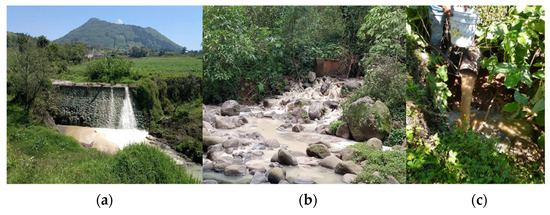
Figure 1.
(a,b) In both images, shows the areas the discharge of wastewater from the dairy industry (c) Wastewater intake area for treatment in constructed wetland.
Some recent studies have treated WDI, such as Schirano et al. [17], who treated dairy wastewater in Sicily, Italy, through pilot-scale horizontal subsurface flow wetlands (HSSFWs) using Arundo donax L. and Cyperus alternifolius L. as emergent vegetation, achieving removals of 77.8% and 61.6% for BOD5 and COD, respectively. Sharma et al. [18] used pilot-scale HSSFWs planted with Typha domingensis and river gravel as a filter medium in Santa Fe, Argentina, as tertiary treatment for effluents from a dairy factory. The authors obtained removal efficiencies of 78.4%, 57.9%, 68.7%, 25.7%, 47.8%, and 29.9% for TSS, BOD, COD, TKN, NO3−, and TP, respectively. In another study carried out in Dehradun, India, Sharma et al. [19] used a hybrid constructed wetland system composed of a vertical and horizontal wetland connected in series for the treatment of dairy farm wastewater. They used Arundo donax L., Hibiscus esculentus L., and Solanum melongena L. as emergent vegetation and achieved removals of 92.2%, 95%, 83.6%, and 86.1% for TSS, BOD3, total N and P, respectively. In addition, in Westphalen, Brazil, Pelissari et al. [20] treated the same type of effluent in vertically and horizontally constructed wetlands planted with Typha domingensis, managing to remove 23–59% of TN and 58–80% of NH4+.
The information reported on constructed wetlands for the treatment of dairy wastewater is limited, and there is no clear consensus on their correct design, use of vegetation, or filter media, and the studies have been carried out mainly on a laboratory scale. According to Vymazal [21], laboratory-level studies do not allow decisions to be made about the design of the systems since the conditions are controlled and the waters are generally synthetic. Therefore, the results do not reflect the behavior of the systems in real conditions. The above generates the need to study these systems in real operating conditions or on a pilot scale. This would generate knowledge to have a clearer picture of the operating conditions, both in real weather conditions and in the face of flow and operation variations, as well as expand the group of plants used as vegetation. In tropical climates, there are numerous plant species that have not yet been evaluated [22]. Although some of these plants have been evaluated for wastewater treatment, there remains an abundance of species that have not yet been studied, especially in the context of treating rivers that are completely contaminated by dairy and domestic wastewater.
Therefore, this study had the following objectives: to evaluate the efficiency of HSSFWs at pilot scale planted with Hippeastrum striatum and Heliconia lastisphata for the treatment of contaminated river waters by wastewater from the dairy industry and domestic wastewater in tropical climates (COD, TSS, TP, TN, N-NH4), and to evaluate the capacity for survival, adaptation, and development of the species Hippeastrum striatum and Heliconia lastisphata in constructed wetlands that treat contaminated river waters by the dairy industry and domestic wastewater. The results of this study are of interest to the scientific community and decision-makers in developing countries that have similar problems with tropical climate conditions. The inclusion of the design, construction, and supervision criteria of these systems will allow the technology to be scaled to a solution to complex social problems such as the contamination of rivers by this type of wastewater. Additionally, it will be possible to establish the tolerance capacity to contaminants and survival of the species Hippeastrum striatum and Heliconia lastisphata in the treatment of these waters.
2. Methodology
2.1. Study Area
This study was conducted at the facilities of the Technological Institute of Misantla, Misantla campus, Veracruz, Mexico (latitude 19.560 north and longitude 96.510 west), at an elevation of 300 m above sea level, under a humid subtropical climate with an average annual precipitation of 2036.4 mm and an average annual temperature of 22.7 °C.
2.2. HSSFW Design
WDI was obtained from the Naolinco River in the municipality of Miahuatlán, Veracruz, Mexico, and transported to the experimental site in containers (Figure 1c), where a sedimentation pretreatment was carried out for 48 h. The system consisted of a grease trap, allowing for the retention of these residues before their treatment in the system. Within each cell, 12 passive aeration tubes were placed to oxygenate the system, and enhance removal processes, and oxygenate plant roots (Figure 2).
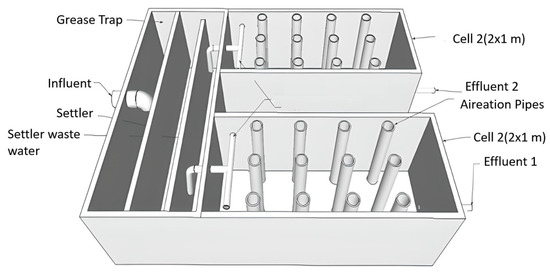
Figure 2.
Isometric view of the interior of the constructed wetland for treating wastewater from cheese factories.
The actual volume was 780,000 mL, and the flow rate (Q) was 1805 mL s−1. A hydraulic retention time (HRT) of 5 days was determined. A 60-day adaptation period was carried out for Hippeastrum striatum and Heliconia lastisphata from 3 September 2020, to 3 November 2020. Subsequently, the effluent was gradually diluted with tap water to reach a 50:50 v/v ratio, which was tolerated by both plant species. After the 2-month adaptation period for Hippeastrum striatum and Heliconia lastisphata, the study of contaminant removal processes began on 1 December 2020, and concluded on 15 April 2021 (a total of 136 days).
Figure 3 shows the HSSFW system for the treatment of cheese whey wastewater. The cells were filled with red tezontle or red volcanic gravel, which is a highly porous construction material that has excellent properties conducive to the adsorption processes carried out in these CW systems [22]. The size of the tezontle varied from 1 to 3 mm in diameter. In one cell, 12 individuals of Hippeastrum striatum were planted, and in the other, 12 individuals of Heliconia lastisphata, with an approximate spacing of 20 cm between each plant (Figure 3). Each plant was numbered from left to right and from top to bottom, starting from plant 1 (P1) to plant 12 (P12) in both the Hippeastrum striatum spp. and Heliconia lastisphata cells. Both plant species were collected from their natural environment in the area of Misantla, Veracruz; only healthy plants of uniform size between 15 and 20 cm were chosen.
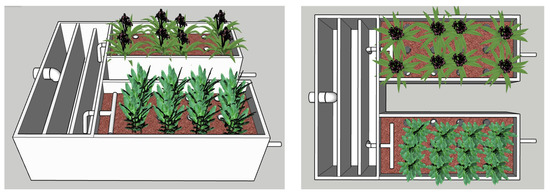
Figure 3.
Distribution of plants in each of the cells used in the study.
2.3. Vegetative Development
To carry out the control of plant survival and adaptation, all plants were properly labeled and numbered. The parameters measured were: plant height, number of shoots, number of leaves, and number of flowers. Measurements were made at the beginning and end of the experiment. Plant height was measured using a tape measure, and the rest of the parameters were monitored visually.
2.4. Characterization of Wastewater from the River Contaminated with Effluents from the Dairy Industry
Table 1 shows the characterization of the river water contaminated with dairy wastewater. On the other hand, Table 2 shows the characterization of the wastewater diluted with tap water (50:50 v/v) that was deposited in the feed tank. The parameters measured were Chemical Oxygen Demand (COD), Total Suspended Solids (TSS), Total Phosphorus (TP), Total Nitrogen (TN), Ammonium Nitrogen (NH4-N), Dissolved Oxygen (DO), and pH. Sampling and physicochemical analyses were carried out every 15 days.

Table 1.
Parameters evaluated in the influent used in the plant adaptation process.

Table 2.
Parameters measured during the characterization of the WDI and dilution.
2.5. Statistical Analysis
Statistical analysis was conducted using Minitab software, version 17.0. The standard error was calculated to evaluate the variables studied. The one-way analysis of variance (ANOVA) was utilized to analyze treatment results and determine significant differences in percent removal for each plant species using Tukey’s multiple comparison test. All tests were conducted at a significance level of p ≤ 0.05.
3. Results and Discussion
3.1. Vegetative Development
Both species had the capacity to adapt to and tolerate the contaminated environment of the CWs, according to all the measured parameters (Table 3). However, the species H. striatum had a more notable development because the data obtained in this study were similar to the data reported in the literature on the development of this species in its natural environment.

Table 3.
Development of vegetation in the treatment of river water contaminated with whey.
It should be noted that this species has been little studied in wastewater treatment in constructed wetlands. The maximum height of H. striatum was 64 cm, and its average height at the end of the experiment was 58.3 ± 6.2, which is greater than that reported by [23], who studied the growth of this species in the soil of a horticultural farm and reported a maximum height of 24.62 cm in a period of 60 days. This growth was believed to have been influenced by the long HRT, since in another study with a similar HRT, plant growth and contaminant removal efficiency were greater than in studies with a short HRT [24,25]. Furthermore, due to the tropical origin of this species, there is no real period of inactivity in its growth and development cycle [23]. The average number of shoots was also notable (0.6 ± 0.5), since at the end of the experiment, seven of the twelve plants initially planted had produced a shoot. This may be due to the fact that, unlike other species, H. striatum has high bulbiferous quality, that is, easy vegetative multiplication [26]. This species also had early and abundant flowering. Fishchuk [27] mentions that the inflorescence in the genus H. striatum generally varies from 2 to 13 large flowers, which coincides with the average number of flowers in this experiment (7 ± 1.4). This abundant flowering and its rapid vegetative multiplication could be due to the amount of nitrogen available in river water contaminated with dairy and domestic waste since this nutrient plays a crucial role in the reproductive phases of plants [17,20].
With respect to the species Heliconia spp., despite being a tropical ornamental species that has already been widely studied in the treatment of various wastewaters [9,21,28], its development in this study was not vigorous. Heliconia spp. is a species that is distinguished by its rapid growth, reaching heights greater than one meter in its first months of growth in its natural environment [29,30]. However, in this study, it only reached an average height of 74 ± 8.7 cm. Costa et al. [31] report that the flowering production of this species is usually high. In this study, although its appearance was healthy and green, the fact that this wastewater lacked phosphorus in its composition could have affected its flowering and plant multiplication. Since phosphorus is a basic nutrient in the development of plants, it helps form new roots and the production of flowers [32,33].
3.2. Dissolved Oxygen and pH
Figure 4a shows the change in dissolved oxygen (DO) removal throughout the experiment. Initially, the inlet DO concentration was at 5.7 ± 0.17 mg L−1, with a decrease at the outlet to 2.83 ± 0.09 mg L−1 for Heliconia lastisphata and 2.98 ± 0.1 mg L−1 for Hippeastrum striatum. No significant variations were found between the two species regarding DO changes. The elevated temperatures in the tropical climate where the investigation took place may have influenced anaerobic processes in the wetland, where the microbial consortium is involved in the degradation of organic matter.
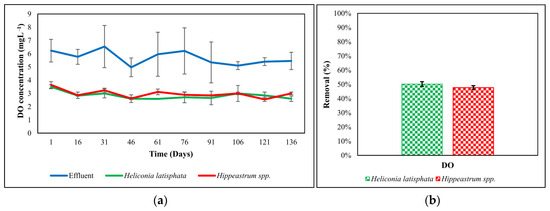
Figure 4.
(a) Temporal behavior of DO removal, (b) Percentage of DO removal.
Previous research, such as that conducted by Vymazal and Kröpfelová [34], has indicated that systems with very low dissolved oxygen (DO) concentrations in the effluent often experience limited nitrification, meaning that the available oxygen becomes a limiting factor, although, in some cases, a significant reduction in ammonia levels is achieved [35]. It has also been observed that the distribution of DO is influenced by microbial activity.
A significant change (p < 0.05) in pH values was observed after treatment, with a significant difference (p < 0.05) also noted between the two species used. The initial average pH was 5.7 ± 0.05 units and increased to values close to the neutral range in both planted cells. The mean pH for Heliconia lastisphata was 6.81 ± 0.07, and for Hippeastrum striatum, it was 6.52 ± 0.01 (Figure 5). Reeder [36] states that wetland metabolism is defined by deep daily fluctuations in pH and DO. It has been found that intensive plant photosynthesis during the summer can lead to an increase in pH [37].
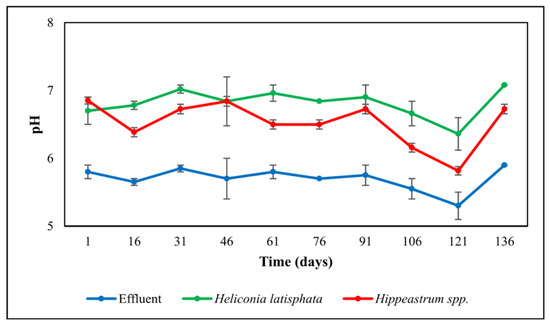
Figure 5.
Temporal pH behavior during the experiment.
3.3. Chemical Oxygen Demand (COD)
COD is an important measure for analyzing water quality. It determines the amount of oxidant consumed during the oxidation of organic substances in a water sample [38,39]. An elevated COD indicates the presence of contaminants, especially in the food industry, such as during dairy product processing [40]. In the influent, the average COD was 4248.4 ± 49.09 mg L−1 (Table 2). A significant decrease in COD concentration was noticeable after treatment of the effluent. In the Heliconia lastisphata cell, the average value obtained was 1361.9 ± 99.22, while in the Hippeastrum striatum cell, it was 1564.4 ± 109.03 mg L−1.
The behavior of both species is shown in Figure 6a, revealing a significant decrease (p ≤ 0.05) in COD concentration values in both conditions. Moreover, significant differences (p ≤ 0.001) in elimination mean efficiencies were identified among the treatments. The highest removal efficiency was achieved in the cell planted with Heliconia lastisphata (67.94 ± 2.27%, Figure 6b), as compared with the one planted with Hippeastrum striatum (63.18 ± 2.42%, Figure 6b). A recent study conducted by Schierano et al. [17] used Typha domingensis in a horizontally subsurface flow-constructed wetland, achieving a total COD removal of 68.7%, a percentage similar to those shown in this study.
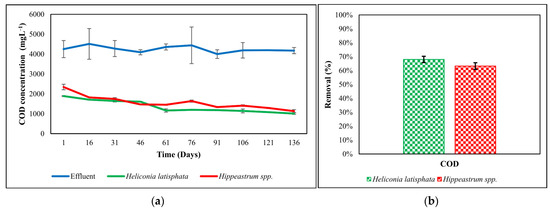
Figure 6.
(a) Temporary behavior of COD removal, (b) percentage of COD removal with different plants.
It is important to highlight that the COD concentrations observed in our study significantly exceed those reported in previous research. For instance, the reference study by Patil & Kurhekar [41] reported an average COD concentration of 2184 ± 417 mg L−1, while Ahmed [42] found an average concentration of 954 ± 86.18 mg L−1 in wastewater from the same industry. The significantly higher values we have recorded in our study indicate a substantially greater organic pollution load. As for free-flow constructed wetlands for cheese-whey wastewater treatment, there are few documented reports.
Specifically for COD [43], we identified removal efficiencies ranging from 55–70% using Heliconia spp. in a tropical climate. However, in the study by Queiroz et al. [44], they used plants such as Polygonum sp. (87.5% COD) and Eichhornia paniculata (90% COD) on the eighth day of the experiment. Heliconia psittacorum has exhibited removal efficiencies of 48–77% [45,46], demonstrating the effectiveness of this species.
3.4. Total Suspended Solids (TSS)
The concentration of TSS in dairy effluents can vary widely, ranging from 20 to 22,000 mg L−1 [47]. In the influent of our study, an average concentration of 264.45 ± 11.26 mg L−1 was recorded. Figure 7a illustrates its behavior throughout the experiment, highlighting that Heliconia lastisphata exhibited the best removal at 46 days of system operation. A significant reduction in TSS concentration was observed in our effluent. The cell planted with Heliconia lastisphata recorded average values of 114.62 ± 6.9 mg L−1, while the cell planted with Hippeastrum striatum obtained values of 134.92 ± 10.3 mg L−1. The implemented systems achieved a considerable decrease in TSS levels, which was statistically significant (p ≤ 0.05).
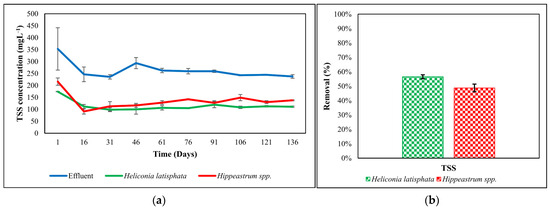
Figure 7.
(a) Temporal behavior of TSS removal (b) Percentage of TSS removal with different plants.
Significant differences (p ≤ 0.001) in average removal efficiencies were observed between the treatments. Heliconia lastisphata exhibited the highest removal efficiency (56.49 ± 1.39%), in contrast to Hippeastrum striatum (48.79 ± 2.63%) (Figure 7b). In the study by Mohamed et al. [48], a significant reduction in TSS concentration in the effluent was observed, decreasing from 1975 ± 825 mg L−1 to 108 ± 96 mg L−1, achieving a higher removal efficiency (94.6%). However, it is important to note that, unlike our experiment, they used ferric chloride as a chemical coagulant to enhance the wastewater treatment process. Heliconia angusta has the capacity to remove up to 81.95% of TSS [49].
It is important to note that this wetland differs in configuration and plant species from other studies that have reported higher removal rates ranging from 30% to 99% [47]. These results are consistent with what was reported by Mohammed & Ismail [50], who achieved TSS removal efficiencies with Canna indica in a microcosm within a range of 99.2% to 93.4% for a similar type of water. In a laboratory-scale study that employed vertical flow-constructed wetlands to treat dairy wastewater, Canna indica plantations achieved TSS removal efficiency in the range of 64.2% to 74.5%. These findings underscore the capability of constructed wetlands and the species Canna indica to enhance the quality of dairy industry wastewater.
3.5. Total Nitrogen (TN) Removal
The results of our study reveal a significant decrease in total nitrogen concentrations in the treated effluent (17.16 ± 1.22 mg L−1). Significantly lower average TN concentrations (p ≤ 0.05) were observed in the cells planted with Heliconia lastisphata (9.54 ± 1.14 mg L−1) and Hippeastrum striatum (11.91 ± 1.03 mg L−1), demonstrating the effectiveness of constructed wetlands in treating wastewater with high TN concentrations. Figure 8a also shows that Hippeastrum striatum exhibited the highest removal at 76 days from the start of the experiment. This phenomenon can largely be attributed to predominant biological processes in wetlands, such as microbial denitrification and nutrient uptake by plants [51].
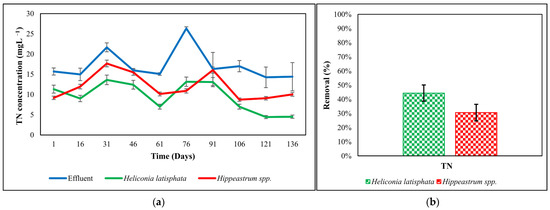
Figure 8.
(a) Temporary TN removal behavior, (b) percent TN removal with different plant species.
The maximum efficiency was achieved in the cell planted with Heliconia lastisphata (44.36 ± 5.74%), in contrast to the cell planted with Hippeastrum striatum (30.59 ± 5.87%) (Figure 8a). During the study period, a significant decrease in TN removal efficiency was observed in the cell planted with Heliconia lastisphata, highlighting the importance of vegetation type in these systems to optimize nitrogen removal. However, it is also relevant to note the influence of environmental conditions, such as temperature. Nitrogen removal rates are likely to vary with changing temperatures, which should be considered when designing and managing similar treatment systems in different regions [52].
The duration of hydraulic retention in these systems is essential for TN removal. Research, such as that by Alayu and Leta [53], has highlighted that extending this period from 1 to 5 days can significantly improve TN removal, increasing from 32.9% to 77.7% using Cyperus alternifolius and Typha latifolia for brewery effluents. This emphasizes the need to consider the configuration and operation of constructed wetlands to achieve optimal nitrogen removal performance in wastewater.
3.6. Ammonium Nitrogen (N-NH4+) Removal
In Figure 9a, the behavior of NH4+ is observed. In the influent evaluated, an initial concentration of 5.72 ± 0.19 mg L−1 was recorded. In relation to the effluent, a significant (p ≤ 0.05) reduction in the concentration of the analyzed parameter was observed. In the cell planted with Heliconia lastisphata, mean values of 2.8 ± 0.09 mg L−1 were obtained, while in the cell with Hippeastrum striatum, values of 2.20 ± 0.06 mg L−1 were recorded. The efficiency achieved in the cell planted with Heliconia lastisphata was 51.07 ± 2.17%, while in the cell of Hippeastrum striatum, it was 50.80 ± 1.91% (Figure 9b), with no significant difference.
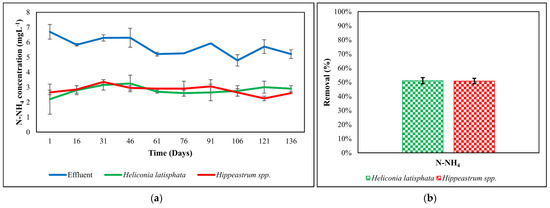
Figure 9.
(a) temporary behavior of removal of N-NH4+, (b) percent removal of N-NH4+ with different plant species.
The most notable removal occurred between 46 and 121 days in the system planted with Hippeastrum striatum, while with Heliconia lastisphata, it occurred 91 days after the start of treatment (Figure 9a). In other studies, it has been observed that average removal reached 73.8% during the treatment of municipal and agroindustrial wastewater over the course of a year [31]. In a tropical environment, a study achieved an efficiency of 96% [54], and another study using Heliconia spp. showed removals close to this study (67–87%) [55]. This could mean that the percentage of removal depends on the vegetation used.
Ammonium represents an essential form of nitrogen and is formed through the ammonification process [56]. It serves as a nutrient source for microorganisms and plants [57]. However, it can also contribute to the eutrophication of water bodies by promoting algae growth and decreasing dissolved oxygen levels. Oxygen transfer rates through wetland beds are a critical factor limiting treatment effectiveness [58]. To deepen our understanding of this phenomenon, further research is essential.
3.7. Total Phosphorus (TP) Removal
Figure 10a shows the behavior of Total Phosphorus (TP) removal in the wastewater treatment system. In the influent, concentrations of 4.73 ± 0.35 mg L−1 were recorded. After treatment, a decrease in TP levels to 3.05 ± 0.17 mg L−1 and 2.51 ± 0.2 mg L−1 was observed in the cells planted with Heliconia lastisphata and Hippeastrum striatum, respectively. The decrease in TP levels was significant (p ≤ 0.05).
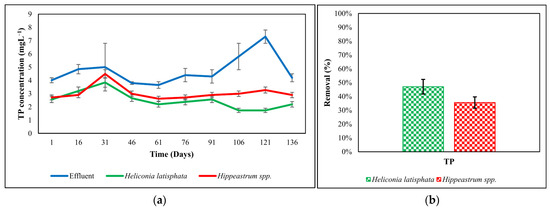
Figure 10.
(a) temporary PT removal behavior, (b) percent PT removal with different plant species.
The average concentration in the analyzed effluent remained at 5.72 ± 0.19 mg L−1. Comparable results have been reported in previous research [59], where Total Phosphorus concentrations in the effluent reached 0.3 mg L−1 with a removal rate of 98%. These results exhibit higher efficiency compared with those obtained in the present study (Figure 10b). However, it should be noted that variation in results may be influenced by the type of wetland employed in the research and the use of Acorus calamus as the plant species in the process.
In another previous study by Schierano et al. [17], systems were compared, with a performance exceeding 88.5% efficiency compared with Phragmites australis with 71.6%. These results outperform those obtained here (Figure 10a). In both studies, wastewater from the dairy industry was treated. In this study, it was noted that the maximum removal of phosphorus occurred at 121 days in systems with Heliconia lastisphata and Hippeastrum striatum (Figure 10a). The presence of phosphorus in water can cause eutrophication, leading to algae proliferation and a decrease in water quality. Therefore, efficient phosphorus removal is essential to maintaining water quality.
This microindustry is subject to two regulations in Mexico: the Official Mexican Standard NOM-001-SEMARNAT-2021, which establishes the maximum allowable limits of pollutants in wastewater discharges into national waters and assets, and the Official Mexican Standard NOM-002-SEMARNAT-1996, which establishes the maximum allowable limits of pollutants in wastewater discharges into urban or municipal sewer systems. Both standards are mentioned because some companies discharge their waste directly into the environment, while others are connected to the sewer network.
In both cases, a wastewater discharge permit is required for discharging into bodies of water or drainage systems, depending on the specific situation. It is important to note that although some industries are connected to the local sewer network, the network does not have a wastewater treatment system, resulting in direct discharges into the Naolinco River [7].
Table 4 records the parameters of the effluent of a cheese factory in the municipality of Miahuatlán and their comparison with the maximum permissible limits established in the NOM-001-SEMARNAT-2021.

Table 4.
Shows data the permissible limits according established by the regulations.
Comparing previous studies that focus on treating wastewater from the dairy industry using Hippeastrum spp. and Heliconia spp. is essential for comprehending the efficiency of these treatment systems and their applicability in various settings. It is important to acknowledge that wastewater characteristics can vary considerably with changes in composition and pollutant load. Variables affecting treatment efficiency include suspended solids, nutrients, and organic matter.
Utilizing Hippeastrum spp. and Heliconia spp. together in constructed wetlands has had little research, despite its potential to enhance treatment performance. Choosing the appropriate plant species can directly influence the system’s capacity to remove specific contaminants. Hence, evaluating the ideal plant suited for the treatment objectives or the presence of vegetation in the local area is crucial, as highlighted in this study.
Table 5 shows different studies that explored dairy industry wastewater treatment and, in some instances, utilized Heliconia spp. or Hippeastrum spp.

Table 5.
Comparison between previous studies that treated water from the dairy industry or used Hippeastrum spp. or Heliconia spp.
The results obtained for total phosphorus removal display relatively low values compared with earlier studies. The findings imply that the vegetation employed in this study may have limited capacity to effectively eliminate phosphates from dairy industry-contaminated water. Therefore, it is necessary to investigate the possibility of utilizing alternative local plant species, as they may exhibit superior TP removal performance, ultimately enhancing the system’s efficiency.
Each wastewater treatment system design possesses distinct characteristics that affect its efficiency, influenced by factors including substrate type, hydraulic retention time, and local climate conditions. The optimization of these systems necessitates a site-specific approach.
There are comparable removal percentages for Chemical Oxygen Demand in previous research, despite variations in the employed substrate. In general, Heliconia spp. has consistently shown the ability to treat organic-loaded wastewater in treatment systems, as demonstrated in previous references (Table 5) [14,17,64,68]. However, studies such as the one conducted in [65], where Heliconia spp. was utilized, have also indicated greater effectiveness in eliminating specific contaminants, such as ibuprofen and caffeine.
Studies that utilized two types of substrates showed greater efficiency in removing Total Suspended Solids, Total Nitrogen, and Total Phosphates than the results obtained in this study. Heliconia spp. showed better efficiency in reducing pollutants compared with Hippeastrum striatum spp. This emphasizes the importance of carefully choosing plant species for Horizontal Subsurface Flow Constructed Wetlands systems, as it can significantly affect the treatment of dairy effluents.
To optimize the system, it is advisable to conduct further research in this area. Incorporating a filtration system at the start of the HSSFW system can retain solid particles and suspended organic matter, enhancing the quality of the treated effluent. Furthermore, adding a sequence of wetland cells can offer supplementary treatment to decrease the concentration of Chemical Oxygen Demand, a crucial indicator of the organic load found in the effluents. Table 4 indicates that Chemical Oxygen Demand values after treatment still exceed regulatory limits.
Evaluating HSSFW when treating contaminated water with dairy industry effluents can promote sustainable practices in this sector. Well-designed systems can efficiently reduce pollutant loads in effluents. However, more research is needed due to a lack of information on treating dairy wastewater with constructed wetlands.
Moreover, this study’s findings suggest that implementing circular economy models is vital to maximize the utilization of whey as a valuable byproduct. This strategy would not only increase its effectiveness but also generate economic and environmental benefits. The circular economy aims to reduce waste and its environmental impact while enhancing the dairy industry’s sustainability by closing the loops of production and consumption and transforming whey into new high-value products. The circular economy aims to reduce waste and its environmental impact while enhancing the dairy industry’s sustainability by closing the loops of production and consumption and transforming whey into new high-value products. This approach also creates economic opportunities.
4. Conclusions
The research results indicate that Heliconia latisphata and Hippeastrum striatum can remove contaminants found in dairy wastewater, thus enhancing its quality. However, Heliconia latisphata proved to be more efficient in contaminant removal, while Hippeastrum striatum exhibited better adaptation to the environment, resulting in a higher development of flowers and roots compared with Heliconia latisphata. Despite certain parameters, including total suspended solids and Chemical Oxygen Demand, exceeding the permissible discharge limits established by current regulations after treatment, a reduction of over 50% in these contaminants was achieved. This outcome may imply an improvement in the quality of the bodies of water where the treated effluent is released.
Both plant species demonstrated exceptional survival, adaptability, and growth during the study, indicating their potential suitability in comparable treatment systems. However, Heliconia latisphata exhibited superior contaminant removal capabilities, while Hippeastrum striatum maintained better environmental adaptation, resulting in a higher development of flowers and roots compared with Heliconia latisphata. With a more extended experimentation period, it is likely that more conclusive results could be obtained. Our findings suggest the need for additional research that explores the same vegetation in various wetland configurations or considers the implementation of alternative plant species from tropical climates. This perspective aims to enhance the efficacy of contaminant removal and ensure compliance with the quality standards established by prevailing regulations.
Author Contributions
Conceptualization, N.F.M.-D. and L.C.S.H.; methodology, M.S.-H.; software, G.N.; validation, L.C.S.H. and F.Z.; formal analysis, N.F.M.-D.; investigation, N.F.M.-D. and L.C.S.H.; resources, L.C.S.H.; data curation, F.Z.; writing—original draft preparation, G.M.-R. and L.C.S.H.; writing—review and editing, G.M.-R. and G.F.-L.; visualization, N.F.M.-D. and G.F.-L.; supervision, L.C.S.H.; project administration, F.Z. and E.F.-E.; funding acquisition, L.C.S.H. All authors have read and agreed to the published version of the manuscript.
Funding
This research received no external funding.
Data Availability Statement
Not applicable.
Acknowledgments
We are grateful to the National Technological Institute of Mexico (Tecnológico Nacional de México) for encouraging research through the call for technological development and innovation projects for students 2020, with proyect number 9037.20-PD and name Artificial Neural Network model for pollutant removal analysis in wetlands constructed with sargassum spp. substrate, for the treatment of dairy industry wastewater. To the National Council of Science and Technology (CONAHCYT) in Mexico, for the doctorate in Engineering Sciences at Tecnológico Superior de Misantla.
Conflicts of Interest
The authors declare no conflict of interest.
References
- Boguniewicz-Zablocka, J.; Klosok-Bazan, I.; Naddeo, V. Water quality and resource management in the dairy industry. Environ. Sci. Pollut. Res. 2019, 26, 1208–1216. [Google Scholar] [CrossRef]
- Shigwan, S.; Nikam, S.; Patil, P.; Ohja, P.; Singh, S. Treatment of Dairy Wastewater Using Constructed Wetland. Int. J. Water Resour. Eng. 2022, 8, 55–66. [Google Scholar]
- Valencia, E.; Ramírez, M.L. La industria de la leche y la contaminación del agua. Elementos 2009, 73, 27–31. [Google Scholar]
- Rocha, J.M.; Guerra, A. On the valorization of lactose and its derivatives from cheese whey as a dairy industry by-product: An overview. Eur. Food Res. Technol. 2020, 246, 2161–2174. [Google Scholar] [CrossRef]
- Sirmacekic, E.; Atilgan, A.; Rolbiecki, R.; Jagosz, B.; Rolbiecki, S.; Gokdogan, O.; Niemiec, M.; Kocięcka, J. Possibilities of Using Whey Wastes in Agriculture: Case of Turkey. Energies 2022, 15, 9636. [Google Scholar] [CrossRef]
- Farizoglu, B.; Uzuner, S. The investigation of dairy industry wastewater treatment in a biological high performance membrane system. Biochem. Eng. J. 2011, 57, 46–54. [Google Scholar] [CrossRef]
- Mesa, O.S.L.; Sureda, N.J.; González, G.E. Formación de docentes en educación ambiental: El caso del programa sobre el buen uso del agua en la microcuenca de naolinco, Veracruz. XI Congr. Nac. De Investig. Educ. 2020, 1–10. Available online: https://www.comie.org.mx/congreso/memoriaelectronica/v11/docs/area_03/1183.pdf (accessed on 22 August 2023).
- Parde, D.; Patwa, A.; Shukla, A.; Vijay, R.; Killedar, D.J.; Kumar, R. A review of constructed wetland on type, treatment and technology of wastewater. Environ. Technol. Innov. 2021, 21, 101261. [Google Scholar] [CrossRef]
- Viveros, J.A.F.; Martínez-Reséndiz, G.; Zurita, F.; Marín-Muñiz, J.L.; Méndez, M.C.L.; Zamora, S.; Herazo, L.C.S. Partially Saturated Vertical Constructed Wetlands and Free-Flow Vertical Constructed Wetlands for Pilot-Scale Municipal/Swine Wastewater Treatment Using Heliconia latispatha. Water 2022, 14, 3860. [Google Scholar] [CrossRef]
- Herazo, L.C.S.; Zurita, F.; Nani, G.; Del Ángel-Coronel, O.A.; Aguilar, F.A.A. Treatment of swine effluent mixed with domestic wastewater and vegetation development in monoculture and polyculture horizontal subsurface flow wetlands. Ecol. Eng. 2021, 173, 106432. [Google Scholar] [CrossRef]
- Saeed, T.; Yadav, A.K.; Miah, J. Landfill leachate and municipal wastewater co-treatment in microbial fuel cell integrated unsaturated and partially saturated tidal flow constructed wetlands. J. Water Process. Eng. 2022, 46, 102633. [Google Scholar] [CrossRef]
- Wdowczyk, A.; Szymańska-Pulikowska, A.; Gałka, B. Removal of selected pollutants from landfill leachate in constructed wetlands with different filling. Bioresour. Technol. 2022, 353, 127136. [Google Scholar] [CrossRef]
- Riggio, V.A.; Ruffino, B.; Campo, G.; Comino, E.; Comoglio, C.; Zanetti, M. Constructed wetlands for the reuse of industrial wastewater: A case-study. J. Clean. Prod. 2018, 171, 723–732. [Google Scholar] [CrossRef]
- Licata, M.; Ruggeri, R.; Iacuzzi, N.; Virga, G.; Farruggia, D.; Rossini, F.; Tuttolomondo, T. Treatment of Combined Dairy and Domestic Wastewater with Constructed Wetland System in Sicily (Italy). Pollutant Removal Efficiency and Effect of Vegetation. Water 2021, 13, 1086. [Google Scholar] [CrossRef]
- Licata, M.; Farruggia, D.; Tuttolomondo, T.; Iacuzzi, N.; Leto, C.; Di Miceli, G. Seasonal response of vegetation on pollutants removal in constructed wetland system treating dairy wastewater. Ecol. Eng. 2022, 182, 106727. [Google Scholar] [CrossRef]
- Sultana, M.-Y.; Akratos, C.S.; Vayenas, D.V.; Pavlou, S. Constructed wetlands in the treatment of agro-industrial wastewater: A review. Chem. Ind. 2015, 69, 127–142. [Google Scholar] [CrossRef]
- Schierano, M.C.; Panigatti, M.C.; Maine, M.A.; Griffa, C.A.; Boglione, R. Horizontal subsurface flow constructed wetland for tertiary treatment of dairy wastewater: Removal efficiencies and plant uptake. J. Environ. Manag. 2020, 272, 111094. [Google Scholar] [CrossRef]
- Sharma, P.K.; Rausa, K.; Rani, A.; Mukherjee, S.; Kumar, M. Biopurification of dairy farm wastewater through hybrid constructed wetland system: Groundwater quality and health implications. Environ. Res. 2021, 200, 111426. [Google Scholar] [CrossRef]
- Pelissari, C.; Sezerino, P.H.; Decezaro, S.T.; Wolff, D.B.; Bento, A.P.; Junior, O.d.C.; Philippi, L.S. Nitrogen transformation in horizontal and vertical flow constructed wetlands applied for dairy cattle wastewater treatment in southern Brazil. Ecol. Eng. 2014, 73, 307–310. [Google Scholar] [CrossRef]
- Vymazal, J. Removal of nutrients in various types of constructed wetlands. Sci. Total Environ. 2007, 380, 48–65. [Google Scholar] [CrossRef]
- Sandoval, L.; Zamora-Castro, S.A.; Vidal-Álvarez, M.; Marín-Muñiz, J.L. Role of Wetland Plants and Use of Ornamental Flowering Plants in Constructed Wetlands for Wastewater Treatment: A Review. Appl. Sci. 2019, 9, 685. [Google Scholar] [CrossRef]
- Nakase, C.; Zurita, F.; Nani, G.; Reyes, G.; Fernández-Lambert, G.; Cabrera-Hernández, A.; Sandoval, L. Nitrogen Removal from Domestic Wastewater and the Development of Tropical Ornamental Plants in Partially Saturated Mesocosm-Scale Constructed Wetlands. Int. J. Environ. Res. Public Health 2019, 16, 4800. [Google Scholar] [CrossRef]
- Khalid, J.M.; Mizanur, R.M.; Moshiur, R.M. Effect of Bulb Cutting and Pot Medium on Propagationof Hippeastrum (Hippeastrum hybridum Hort.). J. Ornam. Plants 2014, 4, 123–132. [Google Scholar]
- Ghosh, D.; Gopal, B. Effect of hydraulic retention time on the treatment of secondary effluent in a subsurface flow constructed wetland. Ecol. Eng. 2010, 36, 1044–1051. [Google Scholar] [CrossRef]
- Akratos, C.; Van Oirschot, D.; Tekerlekopoulou, A.; Vayenas, D.V.; Stefanakis, A.I. Dairy Wastewater Treatment with Constructed Wetlands: Experiences from Belgium, the Netherlands and Greece. In Constructed Wetlands for Industrial Wastewater Treatment; Wiley: Hoboken, NJ, USA, 2018; pp. 175–202. [Google Scholar] [CrossRef]
- Rodriguez, M.O.A.; Honfi, I.A.; Daviña, J. Regeneración de bulbos de Hippeastrum striatum y Habranthus Brachyandrus (Amaryllidaceae) sometidos a corte longitudinal. Boletín Soc. Argent. Botánica 2018, 53, 609–618. [Google Scholar] [CrossRef]
- Fishchuk, O. Comparative flower morphology in Hippeastrum striatum (Lam.) H.E. Moore. (Amaryllidaceae). Ukr. J. Ecol. 2021, 11, 273–278. [Google Scholar]
- Rentería, F.F.G.; García, R.A.A. Determinación de la emisión de sustancias tóxicas gaseosas en el relleno sanitario Curva de Rodas de la ciudad de Medellín. Fac. Ingeniería. Univ. Antioq. 2005, 33, 70–83. [Google Scholar]
- Jerez, E. Revisión bibliográfica El cultivo de las heliconias. Cultiv. Trop. 2007, 28, 29–35. [Google Scholar]
- Landero-Torres, I.; García-Martínez, M.; Galindo-Tovar, M.E.; Leiva-Ovalle, O.R.; Lee-Espinosa, H.E.; Murguía-González, J.; Negrín-Ruiz, J. An Ornamental Heliconias Crop as a Reservoir of the Native Myrmecofauna: A case of Tropical Horticulture in Central Veracruz, Mexico. Southwest. Èntomol. 2014, 39, 135–146. [Google Scholar] [CrossRef][Green Version]
- Costa, A.S.; Nogueira, L.C.; dos Santos, V.F.; Camara, T.R.; Loges, V.; Willadino, L. Storage of cut Heliconia bihai (L.) cv. Lobster Claw flowers at low temperatures. Rev. Bras. Eng. Agrícola Ambient. 2011, 15, 966–972. [Google Scholar] [CrossRef]
- Maucieri, C.; Salvato, M.; Borin, M. Vegetation contribution on phosphorus removal in constructed wetlands. Ecol. Eng. 2020, 152, 105853. [Google Scholar] [CrossRef]
- Shaukat, S.A.; Shah, S.A.; Ishaq, Y.; Ahmed, M.; Shaukat, S.K.; Shoukat, S.W. Influence of phosphorus fertilization on gladiolus corm and flower production. Sci. J. Agric. 2012, 1, 105–111. [Google Scholar]
- Vymazal, J.; Kröpfelová, L. Is Concentration of Dissolved Oxygen a Good Indicator of Processes in Filtration Beds of Horizontal-Flow Constructed Wetlands? In Wastewater Treatment, Plant Dynamics and Management in Constructed and Natural Wetlands; Springer: Dordrecht, The Netherlands, 2008; pp. 311–317. [Google Scholar] [CrossRef]
- Ding, Y.; Song, X.; Wang, Y.; Yan, D. Effects of dissolved oxygen and influent COD/N ratios on nitrogen removal in horizontal subsurface flow constructed wetland. Ecol. Eng. 2012, 46, 107–111. [Google Scholar] [CrossRef]
- Reeder, B.C. Assessing constructed wetland functional success using diel changes in dissolved oxygen, pH, and temperature in submerged, emergent, and open-water habitats in the Beaver Creek Wetlands Complex, Kentucky (USA). Ecol. Eng. 2011, 37, 1772–1778. [Google Scholar] [CrossRef]
- Yin, X.; Zhang, J.; Hu, Z.; Xie, H.; Guo, W.; Wang, Q.; Ngo, H.H.; Liang, S.; Lu, S.; Wu, W. Effect of photosynthetically elevated pH on performance of surface flow-constructed wetland planted with Phragmites australis. Environ. Sci. Pollut. Res. 2016, 23, 15524–15531. [Google Scholar] [CrossRef]
- Bendicho, C.; Lavilla, I. Sewage. In Reference Module in Chemistry, Molecular Sciences and Chemical Engineering; Elsevier: Amsterdam, The Netherlands, 2017. [Google Scholar] [CrossRef]
- Dhanjai; Sinha, A.; Zhao, H.; Chen, J.; Mugo, S.M. Determination of Chemical Oxygen Demand: An Analytical Approach. In Reference Module in Chemistry, Molecular Sciences and Chemical Engineering; Elsevier: Amsterdam, The Netherlands, 2018. [Google Scholar] [CrossRef]
- Noukeu, N.; Gouado, I.; Priso, R.; Ndongo, D.; Taffouo, V.; Dibong, S.; Ekodeck, G. Characterization of effluent from food processing industries and stillage treatment trial with Eichhornia crassipes (Mart.) and Panicum maximum (Jacq.). Water Resour. Ind. 2016, 16, 1–18. [Google Scholar] [CrossRef]
- Patil, N.S.; Kurhekar, J.V. An investigation of monthly variation of different physicochemical parameters of dairy industry effluent. Sustain. Agric. Food Environ. Res. 2021, 9, 393–407. [Google Scholar] [CrossRef]
- Ahmed, O.M. Point Prevalence Survey for Screening of Carbapeneme Resistant Enterobacteriaceae in ICU Patients using CDC Protocol and Chromogenic Agar. Int. J. Curr. Microbiol. Appl. Sci. 2017, 6, 1884–1893. [Google Scholar] [CrossRef][Green Version]
- Fernández-Echeverria, E.; Misantla, T.N.d.M.T.d.; Herazo, L.S.; Zurita, F.; Betanzo-Torres, E.; Sandoval-Herazo, M. Development of Heliconia latispatha in constructed wetlands, for the treatment of swine/domestic wastewater in tropical climates, with PET as a substitute for the filter medium. Rev. Mex. Ing. Química 2022, 21, 1–20. [Google Scholar] [CrossRef]
- Queiroz, R.D.C.S.D.; Andrade, R.S.; Dantas, I.R.; Ribeiro, V.D.S.; Neto, L.B.R.; Neto, J.A.D.A. Use of native aquatic macrophytes in the reduction of organic matter from dairy effluents. Int. J. Phytoremediat. 2017, 19, 781–788. [Google Scholar] [CrossRef]
- Méndez-Mendoza, A.S.; Bello-Mendoza, R.; Herrera-López, D.; Mejía-González, G.; Calixto-Romo, A. Performance of constructed wetlands with ornamental plants in the treatment of domestic wastewater under the tropical climate of South Mexico. Water Pract. Technol. 2015, 10, 110–123. [Google Scholar] [CrossRef]
- Decezaro, S.T.; Wolff, D.B.; Araújo, R.K.; Faccenda, H.B.; Perondi, T.; Sezerino, P.H. Vertical flow constructed wetland planted with Heliconia psittacorum used as decentralized post-treatment of anaerobic effluent in Southern Brazil. J. Environ. Sci. Health Part A 2018, 53, 1131–1138. [Google Scholar] [CrossRef] [PubMed]
- Moreira, F.D.; Saraiva, C.B.; Bottrel, S.E.C.; Dias, E.H.O. Feasibility study of constructed wetlands for the treatment of dairy effluents. Rev. AIDIS Ing. Y Cienc. Ambientales. Investig. Desarro. Y Práctica 2021, 14, 176. [Google Scholar] [CrossRef]
- Mohamed, A.; Siggins, A.; Healy, M.; Huallacháin, D.; Fenton, O.; Tuohy, P. A novel hybrid coagulation-constructed wetland system for the treatment of dairy wastewater. Sci. Total Environ. 2022, 847, 157567. [Google Scholar] [CrossRef] [PubMed]
- Saumya, S.; Akansha, S.; Rinaldo, J.; Jayasri, M.; Suthindhiran, K. Construction and evaluation of prototype subsurface flow wetland planted with Heliconia angusta for the treatment of synthetic greywater. J. Clean. Prod. 2015, 91, 235–240. [Google Scholar] [CrossRef]
- A Mohammed, N.; Ismail, Z.Z. Green sustainable technology for biotreatment of actual dairy wastewater in constructed wetland. J. Chem. Technol. Biotechnol. 2020, 96, 1197–1204. [Google Scholar] [CrossRef]
- Rampuria, A.; Gupta, A.B.; Brighu, U. Nitrogen transformation processes and mass balance in deep constructed wetlands treating sewage, exploring the anammox contribution. Bioresour. Technol. 2021, 314, 123737. [Google Scholar] [CrossRef]
- Tanner, C.; Depree, C.; Sukias, J.; Wright-Stow, A.; Burger, D.; Goeller, B. Constructed Wetland Practitioner Guide: Design and Performance Estimates; DairyNZ: Hamilton, New Zealand, 2022. [Google Scholar]
- Alayu, E.; Leta, S. Effectiveness of two-stage horizontal subsurface flow constructed wetland planted with Cyperus alternifolius and Typha latifolia in treating anaerobic reactor brewery effluent at different hydraulic residence times. Environ. Syst. Res. 2020, 9, 25. [Google Scholar] [CrossRef]
- Ramírez, S.; Torrealba, G.; Lameda-Cuicas, E.; Molina-Quintero, L.; Stefanakis, A.I.; Pire-Sierra, M.C. Investigation of pilot-scale constructed wetlands treating simulated pre-treated tannery wastewater under tropical climate. Chemosphere 2019, 234, 496–504. [Google Scholar] [CrossRef]
- Marlena, B.; Yuliasni, R.; Sartamtomo, S. Removal of Ammonia on Catfish Processing Wastewater using Horizontal Sub-Surface Flow Constructed Wetland (HSSFCW). J. Ris. Teknol. Pencegah. Pencemaran Ind. 2018, 9, 15–21. [Google Scholar] [CrossRef][Green Version]
- Kaushal, M.; Wani, S.P.; Patil, M.D. Harnessing Microbial Potential for Wastewater Treatment in Constructed Wetlands. In Sustainable Green Technologies for Environmental Management; Springer: Singapore, 2019; pp. 271–282. [Google Scholar] [CrossRef]
- Tavares, O.C.H.; Santos, L.A.; de Araújo, O.J.L.; Bucher, C.P.C.; García, A.C.; Arruda, L.N.; de Souza, S.R.; Fernandes, M.S. Humic acid as a biotechnological alternative to increase N-NO3- or N-NH4+ uptake in rice plants. Biocatal. Agric. Biotechnol. 2019, 20, 101226. [Google Scholar] [CrossRef]
- Wu, S.; Zhang, D.; Austin, D.; Dong, R.; Pang, C. Evaluation of a lab-scale tidal flow constructed wetland performance: Oxygen transfer capacity, organic matter and ammonium removal. Ecol. Eng. 2011, 37, 1789–1795. [Google Scholar] [CrossRef]
- Xu, R.; Zhang, Y.; Liu, R.; Cao, Y.; Wang, G.; Ji, L.; Xu, Y. Effects of different substrates on nitrogen and phosphorus removal in horizontal subsurface flow constructed wetlands. Environ. Sci. Pollut. Res. 2019, 26, 16229–16238. [Google Scholar] [CrossRef] [PubMed]
- Mantovi, P.; Piccinini, S.; Marmiroli, M.; Marmiroli, N. Constructed wetlands are suitable to treat wastewater from Italian cheese productions. Water Pract. Technol. 2011, 6, wpt2011045. [Google Scholar] [CrossRef]
- Schierano, M.C.; Panigatti, M.C.; Maine, M.A. Horizontal subsurface flow constructed wetlands for tertiary treatment of dairy wastewater. Int. J. Phytoremediat. 2018, 20, 895–900. [Google Scholar] [CrossRef] [PubMed]
- Yazdani, V.; Golestani, H.A. Advanced treatment of dairy industrial wastewater using vertical flow constructed wetlands. Desalination Water Treat. 2019, 162, 149–155. [Google Scholar] [CrossRef]
- Galve, J.C.A.; Sundo, M.B.; Camus, D.R.D.; De Padua, V.M.N.; Morales, R.D.F. Series Type Vertical Subsurface Flow Constructed Wetlands for Dairy Farm Wastewater Treatment. Civ. Eng. J. 2021, 7, 292–303. [Google Scholar] [CrossRef]
- Minakshi, D.; Sharma, P.K.; Rani, A. Effect of filter media and hydraulic retention time on the performance of vertical constructed wetland system treating dairy farm wastewater. Environ. Eng. Res. 2021, 27, 200436. [Google Scholar] [CrossRef]
- De Oliveira, M.; Atalla, A.A.; Frihling, B.E.F.; Cavalheri, P.S.; Migliolo, L.; Filho, F.J.M. Ibuprofen and caffeine removal in vertical flow and free-floating macrophyte constructed wetlands with Heliconia rostrata and Eichornia crassipes. Chem. Eng. J. 2019, 373, 458–467. [Google Scholar] [CrossRef]
- AL Falahi, O.A.; Abdullah, S.R.S.; Abu Hasan, H.; Othman, A.R.; Ewadh, H.M.; Al-Baldawi, I.A.; Kurniawan, S.B.; Imron, M.F.; Ismail, N. Simultaneous removal of ibuprofen, organic material, and nutrients from domestic wastewater through a pilot-scale vertical sub-surface flow constructed wetland with aeration system. J. Water Process. Eng. 2021, 43, 102214. [Google Scholar] [CrossRef]
- Orduña-Gaytán, F.; Vallejo-Cantú, N.A.; Alvarado-Vallejo, A.; Rosas-Mendoza, E.S.; Sandoval-Herazo, L.C.; Alvarado-Lassman, A. Evaluation of the Removal of Organic Matter and Nutrients in the Co-Treatment of Fruit and Vegetable Waste Using a Bioreactor-Constructed Wetlands System. Processes 2022, 10, 278. [Google Scholar] [CrossRef]
- Pérez-Salazar, R.; Mora-Aparicio, C.; Alfaro-Chinchilla, C.; Sasa-Marín, J.; Scholz, C.; Rodríguez-Corrales, J. Biogardens as constructed wetlands in tropical climate: A case study in the Central Pacific Coast of Costa Rica. Sci. Total Environ. 2019, 658, 1023–1028. [Google Scholar] [CrossRef] [PubMed]
Disclaimer/Publisher’s Note: The statements, opinions and data contained in all publications are solely those of the individual author(s) and contributor(s) and not of MDPI and/or the editor(s). MDPI and/or the editor(s) disclaim responsibility for any injury to people or property resulting from any ideas, methods, instructions or products referred to in the content. |
© 2023 by the authors. Licensee MDPI, Basel, Switzerland. This article is an open access article distributed under the terms and conditions of the Creative Commons Attribution (CC BY) license (https://creativecommons.org/licenses/by/4.0/).
